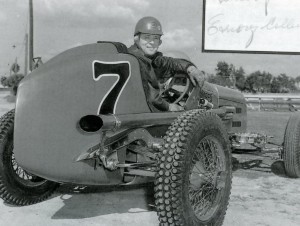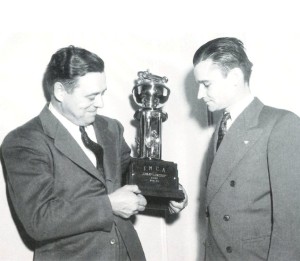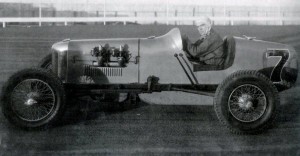By Chad Meyer

Emory Collins aboard the red No. 7 in 1933. (photo courtesy of Show Biz Auto Racing book by Buzz Rose)
One of the greatest sprint car drivers of all time, Emory “Spunk” Collins called LeMars, Iowa home and thrilled millions of race fans across the United States and Canada. Collins was born in Sibley, Iowa in 1904, however, three years later his family moved to Regina, Saskatchewan, Canada.
When Collins turned nine, he started working after school at a garage in Regina. By the time he was in his teens, he developed an interest in the sport of racing. A fledgling driving career took off with a win in a fixed up Model T at the Semons, Saskatchewan track. The following year, he took a Chevy race car to the ‘big’ races at Winnipeg and once again posted the victory.
At the time though, Collins was better known for being an outstanding hockey placer who had played for the Canadian National Team in the Olympics. It was race promoter J. Alex Sloan who brought Collins to the United States in the 1930’s hoping to make him a star for a professional hockey franchise in Chicago that Sloan was bidding on at the time. It didn’t take long for Sloan to find out that Collins was better behind the steering wheel than on the ice and it was then that Collins started his fantastic racing career.
One of the first speed plants Collins raced in the United States was the old Frontier Park in Cedar Rapids, Iowa. By the time his thirty year career was over, Collins was a dominant force in sprint cars and probably raced on more tracks and in front of more fans than possibly any other driver in America. It was drivers like Collins who brought racing to people across the country at hundreds of county and state fair tracks in the US and Canada.
Collins’ battles with Newhall, Iowa’s Gus Schrader were the stuff of legend on the old IMCA fair circuit. In the day’s before super speedway racing, dirt track drivers were larger than life and were heroes to many Americans who only seen them during the county or state fair. In his prime, it was not uncommon to see Collins rubbing shoulders with politicians and movie stars such as Bob Hope, Bing Crosby and Jack Benny.
While his friend Schrader won the IMCA national championship from 1933 to 1937, Collins secured the crown in 1938 on the very last race of the season. Schrader roared back to the point lead and the driving title in 1939 and defended it successfully until his untimely death in 1941.
Since there was no racing from 1942 to 1945 because of World War II, Collins had to wait until 1946 to earn his second IMCA national Championship. He also went on to win the IMCA title in 1947 and 1948 in the famous red Riverside Tire Offenhauser No. 7.
While ’48 may have been Collins last IMCA national title, he continued to post wins across the Midwest. He was a six time winner of the Minnesota State Fair races. In 1950 he posted many wins, including victory at the Sioux Empire Fairgrounds in Sioux Falls, South Dakota. He also won at the Iowa tracks of Bloomfield and Oskaloosa. A return to Canada brought the trophy back from the Lethbridge Exhibition Grounds in Lethbridge, Alberta.
At the conclusion of the 1951 season, Collins and his wife Irene retired after 30 years of racing and settled down LeMars, Iowa. He passed away on June 2, 1982 after suffering a heart attack.
The late Emory Collins joins five other inductees into the Kossuth County Racing Hall of Fame in 2011.


